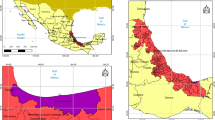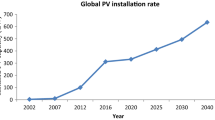Abstract
Radiant cooling technology is a sustainable technology for improving built environment. The past research only studied the thermal performance (e.g., radiant heat flux) based on Kirchhoff’s law while the accuracy and its reasons were seldom analyzed. This article points out that it is necessary to analyze the precondition before applying Kirchhoff’s law directly, because emissivity may not be equal to absorptivity on radiant surfaces. The independence of the emissivity and absorptivity is considered in the new model based on the inapplicability of Kirchhoff’s law. The analysis of sensitivity and relative deviation are performed to investigate the reasons for errors. The sensitivity of emissivity is about 20%—40% more sensitive to radiant heat flux than the absorptivity. Furthermore, the deviation of the heat flux can reach up to 20% when the absorptivity is in the range from 0.4 to 0.9. This deviation is close to the error range of 21.8% estimated in the past. Thence, the discussion based on the theoretical analysis, shows that the errors in past studies were highly caused by the oversimplified preconditions for applying Kirchhoff’s law and the impact of surface absorption was ignored. Additionally, the validation in the past experiments was highly coincidence, since the key independent tests of the absorptivity and radiant heat flux were neglected. Comprehensively, the new model is valuable to provide a reliable solution for future design and analysis of radiant heat exchange when a radiant surface is not locally equilibrium.
















Similar content being viewed by others
Availability of data and materials
The datasets used and/or analyzed during the current study are available from the corresponding author on reasonable request.
Abbreviations
- A :
-
The area of a surface (m2)
- c :
-
The specific heat of the surface layer (J/kgK)
- E :
-
The emission energy by a surface itself (W)
- E con :
-
The energy released by the surface layer in a unit time (J/s)
- En :
-
The entransy for a thermal process (JK)
- E str :
-
The energy stored in the surface layer in a unit time (J/s)
- Ex :
-
The exergy for a thermal process (J)
- G :
-
The locally incident radiation heat flux (W)
- h :
-
The heat transfer coefficient [W/ (m2K)]
- J :
-
The total radiosity leaving by combined emission and reflection (W)
- k :
-
The thermal conductivity of the thermal layer (W/mK)
- m :
-
The mass of the surface layer (kg)
- Q :
-
The amount of heat flux (W)
- q :
-
The density of heat flux (W/m2)
- R :
-
The reflection energy of
- S :
-
The length for radiation between two surfaces (m)
- S y ,x :
-
The sensitivity of x to y (%)
- T :
-
The temperature of a radiant surface (K)
- x :
-
The uncertain factor in a sensitivity analysis
- X 1 ,2 :
-
The view factor from surface 1 to 2
- y :
-
The target variable of a sensitivity analysis
- α :
-
The absorptivity for a surface
- δ :
-
The penetration depth for thermal radiation (m)
- ΔT :
-
The temperature difference of the surface layer from the surface to the inner (K)
- Δ x :
-
The variation of the uncertain factor
- Δy :
-
The variation of the target variable
- ε :
-
The emissivity of a surface
- η :
-
An efficiency or improvement rate (%)
- θ :
-
The normal angle of thermal radiation on a surface (º)
- λ :
-
The spectrum of thermal radiation (m)
- σ :
-
The Stefan-Boltzmann constant
- Φ 1 ,2 :
-
The quantity of radiant heat flux from surface 1 to 2 (W)
- 1 :
-
Any surface 1
- 2 :
-
Any surface 2
- 1 - 5 :
-
From the specific surface 1 to 5
- a :
-
Air
- b :
-
Blackbody
- c :
-
Convective heat exchange
- ctl :
-
Control group
- diss :
-
Dissipation
- i :
-
Internal heat source
- obs :
-
Observation group
- p :
-
Cooling panel
- r :
-
Radiant heat exchange
References
Acikgoz O, Kincay O (2015) Experimental and numerical investigation of the correlation between radiative and convective heat-transfer coefficients at the cooled wall of a real-sized room. Energy Build 108:257–266. https://doi.org/10.1016/j.enbuild.2015.09.013
ASHRAE (2016) 2016 ASHRAE Handbook - HVAC Systems and Equipment. American Society of Heating, Refrigerating, and Air Conditioning Engineers, Atlanta, GA
Babiak J, Olesen BW, Petráš D (2013) Low Temperature Heating and High Temperature Cooling - Embedded Water Based Surface Heating and Cooling Systems, 3rd edn. REHVA
Basu S, Zhang ZM (2009) Ultrasmall penetration depth in nanoscale thermal radiation. Appl Phys Lett 95.https://doi.org/10.1063/1.3238315
Bueno B, Norford L, Pigeon G, Britter R (2012) A resistance-capacitance network model for the analysis of the interactions between the energy performance of buildings and the urban climate. Build Environ 54:116–125. https://doi.org/10.1016/j.buildenv.2012.01.023
Carnielo E, Zinzi M, Fanchiotti A (2014) On the Solar Reflectance Angular Dependence of Opaque Construction Materials and Impact on the Energy Balance of Building Components. Energy Procedia 48:1244–1253. https://doi.org/10.1016/j.egypro.2014.02.141
Causone F, Corgnati SP, Filippi M, Olesen BW (2009) Experimental evaluation of heat transfer coefficients between radiant ceiling and room. Energy Build 41:622–628. https://doi.org/10.1016/j.enbuild.2009.01.004
`Çetin G (2017) Experimental investigation on the heat transfer coefficients of radiant heating systems: Wall, ceiling and wall-ceiling integration. Energy Build 148:311–326. https://doi.org/10.1016/j.enbuild.2017.05.027
Cholewa T, Anasiewicz R, Siuta-Olcha A, Skwarczynski MA (2017) On the heat transfer coefficients between heated/cooled radiant ceiling and room. Appl Therm Eng 117:76–84. https://doi.org/10.1016/j.applthermaleng.2017.02.019
Feng J, Schiavon S, Bauman F (2016) New method for the design of radiant floor cooling systems with solar radiation. Energy Build 125:9–18. https://doi.org/10.1016/j.enbuild.2016.04.048
Guo ZY, Zhu HY, Liang XG (2007) Entransy-A physical quantity describing heat transfer ability. Int J Heat Mass Transf 50:2545–2556. https://doi.org/10.1016/j.ijheatmasstransfer.2006.11.034
Howell JR, Menguc MP, Siegel R (2015) Thermal Radiation Heat Transfer. CRC Press
Karadağ R (2009) The investigation of relation between radiative and convective heat transfer coefficients at the ceiling in a cooled ceiling room. Energy Convers Manag 50:1–5. https://doi.org/10.1016/j.enconman.2008.09.008
Koca A, Gemici Z, Topacoglu Y et al (2014) Experimental investigation of heat transfer coefficients between hydronic radiant heated wall and room. Energy Build 82:211–221. https://doi.org/10.1016/j.enbuild.2014.06.045
Li Z, Zhang D, Chen X, Li C (2020) A comparative study on energy saving and economic efficiency of different cooling terminals based on exergy analysis. J Build Eng 30:101224. https://doi.org/10.1016/j.jobe.2020.101224
Lienhard IV JH, Lienhard V JH, Liehman (2018) A Heat Transfer Textbook, 4th edn. Phlogiston Press, Cambridge, MA
Liu W, Geng Y (2004) Experimental study on solar radiation absorption rate of concrete surface. China Concr Cem Prod 8:8–11. https://doi.org/10.19761/j.1000-4637.2004.04.003
Modest MF (2013) Radiative Heat Transfer, third edit. Elsevier, Oxford
Niu X, Tian Z, Duan B, Wang Z (2014) Influences of heat source forms on the cooling capacity of the radiant cooling terminal. Energy Build 102–111.https://doi.org/10.1016/j.enbuild.2013.12.013
Olesen BW, Michel E, Bonnefoi F, De Carli M (2000) Heat exchange coefficient between floor surface and space by floor cooling - theory or a question of definition. In: ASHRAE Transactions
Peng P, Gong G, Mei X et al (2019) Investigation on thermal comfort of air carrying energy radiant air-conditioning system in south-central China. Energy Build 182:51–60. https://doi.org/10.1016/j.enbuild.2018.10.020
Rhee KN, Olesen BW, Kim KW (2017) Ten questions about radiant heating and cooling systems. Build Environ 112:367–381. https://doi.org/10.1016/j.buildenv.2016.11.030
Saber EM, Tham KW, Leibundgut H (2016) A review of high temperature cooling systems in tropical buildings. Build Environ 96:237–249. https://doi.org/10.1016/j.buildenv.2015.11.029
Shinoda J, Kazanci OB, Tanabe S, Olesen BW (2019) A review of the surface heat transfer coefficients of radiant heating and cooling systems. Build Environ 159:106156. https://doi.org/10.1016/j.buildenv.2019.05.034
Su L, Li N, Zhang X et al (2015) Heat transfer and cooling characteristics of concrete ceiling radiant cooling panel. Appl Therm Eng 84:170–179. https://doi.org/10.1016/j.applthermaleng.2015.03.045
Wang Z, Horseman T, Straub AP, et al (2019) Pathways and challenges for efficient solar-thermal desalination. Sci Adv 5:eaax0763. https://doi.org/10.1126/sciadv.aax0763
Weber T, Jóhannesson G (2005) An optimized RC-network for thermally activated building components. Build Environ 40:1–14. https://doi.org/10.1016/j.buildenv.2004.04.012
Wu J, Liang XG (2008) Application of entransy dissipation extremum principle in radiative heat transfer optimization. Sci China, Ser E Technol Sci 51:1306–1314. https://doi.org/10.1007/s11431-008-0141-6
Yang S, Tao W (2006) Heat transfer, 4th editio. Higher Education Press (HEP), Xi’an
Zhang D, Xia X, Cai N (2016) A dynamic simplified model of radiant ceiling cooling integrated with underfloor ventilation system. Appl Therm Eng 106:415–422. https://doi.org/10.1016/j.applthermaleng.2016.06.017
Zhang HH, Sha WEI, Huang ZX, Shi GM (2018) Flexible and Accurate Simulation of Radiation Cooling with FETD Method. Sci Rep 8:2652. https://doi.org/10.1038/s41598-018-21020-w
Zhang F, Guo H-A, Liu Z, Zhang G (2021) A critical review of the research about radiant cooling systems in China. Energy Build 235:110756. https://doi.org/10.1016/j.enbuild.2021.110756
Zhao K, Liu X-H, Jiang Y (2015) Cooling capacity prediction of radiant floors in large spaces of an airport. Sol Energy 113:221–235. https://doi.org/10.1016/j.solener.2015.01.003
Zhou X, Liu Y, Luo M et al (2019) Thermal comfort under radiant asymmetries of floor cooling system in 2 h and 8 h exposure durations. Energy Build 188–189:98–110. https://doi.org/10.1016/j.enbuild.2019.02.009
Acknowledgements
Not applicable.
Funding
Not applicable.
Author information
Authors and Affiliations
Contributions
All authors contributed to the study conception and design. Material preparation, data collection and analysis were performed by Fan Zhang and Guoqiang Zhang. The first draft of the manuscript was written by Fan Zhang and all authors commented on previous versions of the manuscript. All authors read and approved the final manuscript.
Corresponding author
Ethics declarations
Ethics approval and consent to participate
Disclosure of potential conflicts of interest.
Research involving Human Participants and/or Animals.
Informed consent.
Consent for publication
Not applicable.
Competing interests
The authors did not receive support from any organization for the submitted work.
Additional information
Responsible Editor: Philippe Garrigues
Publisher's note
Springer Nature remains neutral with regard to jurisdictional claims in published maps and institutional affiliations.
Rights and permissions
About this article
Cite this article
Zhang, F., Zhang, G. A novel model concerning the independence of emissivity and absorptivity for enhancing the sustainability of radiant cooling technology. Environ Sci Pollut Res 29, 55675–55690 (2022). https://doi.org/10.1007/s11356-022-19110-4
Received:
Accepted:
Published:
Issue Date:
DOI: https://doi.org/10.1007/s11356-022-19110-4




